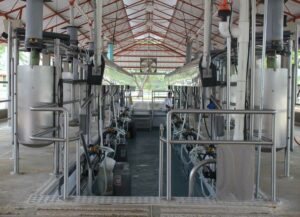Álvaro García
Why early detection of mastitis matters
Each case of mastitis can cost between 200 and 400 dollars, depending on its severity. However, the largest losses often result from subclinical mastitis, udder infections without visible signs but marked by elevated somatic cell counts (SCC) and reduced milk production. These hidden cases account for more than 60% of all mastitis-related losses. They may not cause visible swelling or clots, but subclinical infections still lead to increased SCC, discarded milk, fertility issues, and higher culling rates. That is why detecting mastitis early is one of the smartest investments.
While lab testing and bulk tank somatic cell counts are helpful, they do not give immediate answers. That is where handheld mastitis detectors come in, offering fast, on-the-spot readings. Whether detecting clots or measuring milk conductivity they rely on identifying changes caused by inflammation in the udder. These methods are modified versions of the traditional paddle test, offering faster, more objective detection of mastitis by revealing abnormal milk composition or imbalance in its ion composition.
What to look for in a detector
When choosing a cow-side mastitis detector, dairy producers usually focus on five key things.
- Accuracy, especially the ability to detect subclinical cases.
- Durability since these tools need to survive the barn environment.
- Easy to use, even for staff with limited training.
- Potential for data storage or display readings per quarter.
- Cost, since this tool must earn its place in the milking budget.
When a cow develops mastitis, the levels of sodium and chloride in her milk increase, raising its electrical conductivity. Four of the five detectors featured in this article identify mastitis by measuring these conductivity changes. The fifth detector uses a visual method, detecting milk clots during milking, similar in simplicity to the original CMT paddle test, though based on different principles.
Draminski mastitis detector
Invented in 1989 by Janusz Dramiński, it was among the first practical electronic devices for detecting subclinical mastitis through milk’s electrical resistance. If you want a dependable, rugged device with digital precision, the Draminski is hard to beat. It measures electrical conductivity in milk from each quarter and displays the results on a digital screen. The device is waterproof, shock-resistant, and built for barn conditions, with a uncomplicated design using funnels for sample collection.
Once milk is added and the device is activated, the screen shows four numeric values, one for each quarter. These numbers represent the conductivity levels, which typically rise in infected quarters due to increased sodium and chloride ions. Values are compared automatically, and if one quarter is significantly different (typically 50 units or more), the cow may be flagged for follow-up or treatment.
This tool does not store readings but gives immediate results, making it ideal for farms wanting fast, repeatable detection. It is typically priced around €287 and best suited for mid- to large-sized herds aiming to prevent losses from subclinical mastitis.
Ambic mastitis detector
The Ambic Mastitis Detector was developed by Ambic Equipment Ltd, a UK-based company located in Oxfordshire, England. The original versions were introduced in the early 1990s, designed to detect abnormal milk flow patterns and visual signs like clots or flakes in milk during milking. It is a straightforward, budget-friendly tool used during milking to visually detect clinical mastitis by showing clots or flakes in milk. It fits in line between the milking claw and the milk hose, with milk flowing through a transparent chamber that contains a fine metal mesh screen. Any visible clots are caught on the screen and easily seen through the clear casing. It requires no batteries or electronics, making it dependable and maintenance-free.
When installed inline, the transparent chamber allows real-time observation as milk flows past the screen. Since the detector is installed directly in the milk line, it allows the observation of milk as it flows from the teat to the pipeline. If clots or flakes appear on the screen, it is a clear indication of mastitis in that quarter. It is highly effective for spotting active infections without interrupting milking. Most farms do not install one on every milking unit, instead, they use one or two detectors, rotating them between cows that are fresh, high-risk, or show signs of udder issues. Cleaning is simple: just disconnect the unit after milking, open it, rinse the parts under warm water, and sanitize if needed. At around €29, it is an affordable, practical addition to any herd’s mastitis monitoring routine, especially for smaller dairies or as a secondary check alongside digital tools.
Portable digital mastitis detector
A step below the Draminski in price, it still offers satisfactory performance. It is a single-probe system but offers slightly improved user experience. It often features a more robust casing, clearer display, and enhanced interface that allows the operator to assess all four quarters sequentially, with the device temporarily storing and displaying the most recent readings together on the screen. This helps producers compare values across all quarters without needing to write them down immediately. However, these devices still do not store long-term data or automatically label each reading by teat location. Like the simpler detectors, they require manual sample collection and cleaning between uses. Priced around €191, the portable digital version is ideal for farms that want digital accuracy and convenience at a modest premium, without stepping up to more sophisticated and expensive models like Draminski, which includes built-in milk chambers and more advanced diagnostic features.
Mid-range handheld detector
Mid-range handheld mastitis detectors are affordable, practical tools designed to help producers detect subclinical mastitis by measuring the electrical conductivity of milk. These devices are typically battery-powered, with a basic LCD screen that displays conductivity reading for one quarter at a time. The operator strips milk from a teat into a clean cup, inserts the probe, and reads the result. Higher conductivity values may indicate inflammation due to increased sodium and chloride levels in milk. These detectors are easy to use, durable enough for daily farm work, and require the probe to be cleaned between samples from different quarters. While basic models show just one value at a time and rely entirely on the user to compare readings and identify problem quarters, they remain a cost-effective solution. Most are white-labeled imports from China or Eastern Europe and are sold under various brand names like VetGear, AgriCheck, or FarmTech, with prices typically around €158.
Schalm conductivity disc
The Schalm Conductivity Disc was developed in the Netherlands, sometime in the 1990s or early 2000s, as an affordable, disposable screening tool for subclinical mastitis. It is a unique, disposable tool designed for quick mastitis screening. Unlike electronic devices, it does not require batteries or calibration. Instead, it relies on the scientific principle that milk from an inflamed udder has higher electrical conductivity, caused by the leakage of sodium (Na⁺) and chloride (Cl⁻) ions into the milk and a drop in potassium (K⁺) during mastitis. These ionic shifts alter the milk’s electrical properties.
The disc is made of a chemically treated, cream or yellow-colored material that reacts when dipped into fresh milk. Increased conductivity causes a visible color change—typically shifting from cream/yellow toward pink or red—indicating possible inflammation. This can be compared against a reference scale printed on the packaging. Although it does not offer digital feedback or data storage, it is highly portable, resistant to damage, and ideal for spot checks on high-risk cows. At around €4 per test, it is an affordable, practical backup tool to support routine udder health monitoring on any farm.
Choosing what fits your herd
Each of these devices offers a unique way to stay ahead of mastitis. If you are managing a larger herd and need detailed data fast, a digital conductivity meter like the Draminski or the portable model will provide the best insight. For more basic needs, or if your goal is to visually catch clinical cases, the Ambic detector is simple and cost-effective. And if you just need occasional spot checks, the Schalm disc can help fill that role.
Take-home message
No matter your budget or herd size, early mastitis detection is essential. Cow-side tools, from high-tech digital meters to simple visual screens, help reduce milk losses, avoid unnecessary treatments, and protect herd health. The best detector is the one that fits your workflow and lets you act before infections worsen.
Mastitis can silently drain profits from your dairy herd, especially when subclinical cases go unnoticed. Early detection tools are no longer a luxury. They are an essential part of modern herd management. Whether you invest in a high-end digital detector like Draminski or rely on low-cost options like the CMT paddle, the key is consistency and cow-side monitoring.
Each farm’s needs vary, but tools that help you act early will always pay for themselves in improved health, less milk loss, and lower culling rates.
© 2025 Dellait Knowledge Center. All Rights Reserved.









